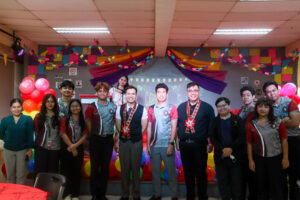Written By John Marion G. De Guzman | November 19, 2025
Coloring Contest
IN the political landscape of the Philippines, certain individuals vested with power are often associated with colors to amplify their history, name, and position. Politics in the country has, as some say, bled into a narrative of hues, shadows, and color — rather than one of truth, accountability, and integrity.
The metaphoric term “Crayon Box Politics” is a grassroots political theory—popularized by a Filipino social media personality, Nikki Gaddi—that strives to delve into and examine the world of personality-driven politics in the Philippines. Think of it as the Philippine politics assembled into a crayon box. As you open the box, different crayons are shown, each of which stands for a distinctive set of beliefs, ideologies, and goals. While some colors are muted and barely noticeable, they are nonetheless important to the box’s structure and balance. On the other hand, others dominate the box with their loud and striking colors, wanting to be picked. If we look at them individually, you’ll be able to recognize certain colors. However, when seen together, they create a complex, sometimes fractured picture of self-driven pursuit, power, and influence, in which personalities frequently take precedence over values and principles.
Through this, people have grown more polarized over the course of the years, tending to patronize certain personalities and figures whom they believe are best suited to lead the country. Labels such as “Dilawan” — associated with the color yellow and the political figures from the Liberal Party, like former President Benigno “Noynoy” Aquino III and his mother former President Cory Aquino, and “UniTeam” — associated with the colors green and red and the political alliance of President Ferdinand “Bongbong” Marcos and Vice President Sara Duterte, had become increasingly integrated in the political landscape for over the past years. “Ah, dilawan ka edi ibig sabihin NPA ka?” or “Kakampink ka pala eh, edi elitista ka?” are just some rhetorical phrases used and are prevalent in social media as discourse regarding political stance. People are labeled with certain stereotypes to fit a convenient narrative just because they support that certain individual; they target them not because of the logic, but because of the color they support.
This occurrence has been prevalent on social media platforms such as Facebook and X. During the campaign period, celebrity politicians are often the center of the spotlight, flooding the algorithm of social media with their ‘budots’ or campaign jingles, rather than presenting substantial platforms, making users interact with such spectacle of a performance. They dominate in every scroll, post, and share. Whether they be negative or positive, they outshine others because of how bright and bold their colors are, while others who are fighting for the rights of the marginalized, such as teachers, farmers, and fisherfolk, are left to the side, shunned away from the spotlight just because their colors are more muted and toned down. Proving that, regardless of how competent your platforms, agendas, and reforms are, candidates who want to spark change are often overlooked and neglected just because of their hues and tones.
The “Color Box Politics” is not only a phenomenon that is seen pervasively with the candidates themselves. It is also often associated with their supporters. Name-calling and associating them with colors has become a resort for people to show their support for certain candidates. People are boxed in certain colors, not because they choose to be there, but because that is what they are perceived as.
Predominantly, the political landscape in the Philippines is what I call a coloring contest. It’s not about the policy, principles, and platforms, but about patronage. Bold personalities and recognizable faces dominate the box — such as red and yellow, garnering the attention of voters in the box of crayons, while less prominent figures are left disregarded — such as pale green and sky blue, because they don’t make enough noise. In the end, the most striking and bold colors grab the spotlight, and voters tend to follow them, leaving the less prominent hues and tones behind.
One can only hope that the Filipino people will eventually look beyond their favorite colors — leaving their fanaticism and patronage behind, and start electing the leaders who will genuinely create and color a better future for the nation. Ultimately, the true measure of being a responsible voter is not determined by the boldness and popularity of the color you support within the box, but rather by the accountability and demand of character and integrity from the candidates. The coloring contest itself ceases to exist once the Filipino people themselves refuse to be dazzled by the brightest hues and colors in the crayon box; instead, by knowing the candidate’s stance and substance, we can paint and color the future of our nation.
Volume 31 | Issue 5




